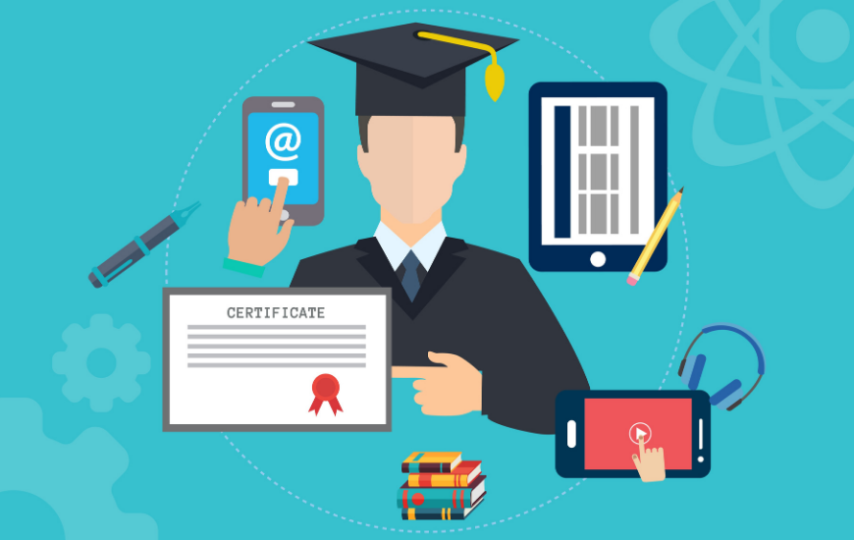Technology continues to affect many fields these days. One of the areas where technology has had such a tremendous impact is literacy. Learning is essential to socio-economic prosperity and job development. These days, many challenges to education can be addressed by mobile learning or mLearning. Immersive and personalized instruction are the advantages that students get from smartphone apps. As the world leans more towards mobile technology trends, it can be expected that mobile technology trends will greatly influence education.
Mobile Technology Trends That Will Shape Mobile Learning
Mobile-based eLearning will continue to be influenced by the latest innovations in technology. There is even no evidence of it ending any time soon. Here are some of the mobile technology trends predicted to have an impact on mobile-based eLearning.
- Augmented Reality
Augmented Reality is anticipated to play a critical role in the next decade. It has been estimated that AR revenue will increase to about USD 161.1 billion by 2025. With AR development tools being inexpensive, it will soon plunge into the learning environment. With smartphones and tablets’ growing use, the mobile learning trend can ramp up exponentially. Thus, allowing AR capabilities. Learning processes are going to be revolutionized by augmented reality applications. These applications carry the experience of users to a whole different level. Thus, making daily activities straightforward yet engaging.
AR is an accessible software that translates digital content into real-world digital projection. These applications are utilized for work, schooling, and even for business. Common goals in leaning on AR is to provide a better experience. With the influx of smartphone users, the need to incorporate it in mobile-based eLearning is enormous.
In the school environment, AR and VR will result in higher student efficiency and learning capacity. These innovations can help turn dull learning into an exciting and immersive experience. It will help ensure that the information presented is instilled adequately in students. Educational images created with drawing software like CorelDraw Graphics Suite can come to life because of AR. This technological advancement can make learning more fun and engaging for students.
- Artificial Intelligence
Smart personal assistants, chatbots, self-driving vehicles, and other AI-powered tools have become common. What was once just a vision is now a real thing. Artificial Intelligence or AI has continuously been a part of human lives. In recent years, it has produced a significant impact on all industries.
Educational institutions now recognize the tremendous potential that AI technology has. It can also help motivate both teachers and students and keep up with the developments as it enters the AI revolution.
- Personalization learning for students
Individuals respond to learning differently. When it comes to education, every individual has personal preferences as well as strengths and weaknesses. Standard instructional approaches, providing a one-size-fits-all solution, make no distinction between classes.
Adaptive learning systems, based on the leaner’s skills, will build correct behavioral profiles for students. It will also help identify interests, behavioral patterns, and difficulties encountered. The curriculum and instructional approaches are tailored to the needs of students. Teachers can offer customized suggestions and change class assignments to allow each student to focus on development.
- Aids In Administrative Tasks
Teachers have to manage many activities, such as arranging instructional content and reviewing homework. These days, it can be done through mobile technology trends. This technology will also help assess tests, handle documents, engage with parents, and more.
AI may elevate their workflow and assist with all the tasks. When they have to go through thousands of exams, automatic marking is a lifesaver. AI will take care of other things, such as planning challenges and keeping the documents up-to-date. It will also be easy to get students’ input on any communication platform.
- Global Approach
By using AI, a global mobile classroom will be more accessible for educational institutions to put in place. There will be no requirement for students to be physically present. That is because AI can connect students to an interactive classroom. Even with learning from a distance, AI often offers social interactions in virtual classes. AI innovations would push the educational sector to the next level. These technological advances would push the educational sector to the next level.
AI offers individuals the chance to achieve their educational goals, no matter where they are in the world. Many who want to pursue their education can now participate. Thanks to AI programs, a student can forget about time and space constraints. Students can adapt and tailor the learning process to their needs and atmosphere at any time, wherever they are located.
- Virtual Reality
Virtual Reality is an interactive technology that has emerged in recent years. It has given a significant boost to online education. It has taken the concept of studying outside the learning space. One of the advantages of using VR technology is that students may learn about the world outside their school environment. That can happen even without leaving the school premises. VR expands educators’ options to consider anywhere they want to bring their learners.
Online interaction is one field of studying and teaching where technology aligns well. It is where learners invest their time and resources. Simply put, today’s students are digital natives. So, it is not shocking to see that VR technology provides a way to immerse students deeper in their learning.
- Cloud Technology
Businesses now move their data to cloud technology as the volume of information generated each day increases. Many iOS and Android apps are hosted on cloud servers. Doing this has helped developers to drop the limited space for learners on their mobile devices. With the advent of AI and machine learning, the volume of data can continue to expand.
Educational institutions do not need to purchase, operate, and manage their own data centers. Instead, when they need them, they can use cloud infrastructure to access computational resources. It would be more comfortable to access databases, storage, and other facilities stored in the cloud. Besides this, the education industry will still be assured that their data on the cloud are safe.
It is possible now for educational institutions to give students interactive classrooms. The definition lowers the expense of development to no small degree. School administrators will also reduce the costs of onboarding daily instructors. Instead, they can collaborate with trained coaches that work remotely and act as cost-effective tools for learning. Teachers can build and offer online classes to students anywhere at the same time. Students can also pose for simulated tests, potentially saving their time and expenses.
- Smart Speakers and Voice Assistants
Voice assistants are going to be the next big trend in the evolution of technology. Voice assistants can perform many tasks that can make life easier. This technology ranges from smartphones, tablets, and special devices such as Google Assistant, Siri, and Alexa. There is no doubt that voice assistants have impacted personal lives. Conversational AI play also starts an increasingly important role. Furthermore, it will eventually make their way into other sectors, including education.
Voice assistants hosted on the cloud are getting smarter with AI and deep learning technologies. With automated speakers and voice assistants’ deployment, people could expect much innovation in the new learning world.
Though not primarily made for educational purposes, many school activities can be taken about by voice assistants. It can also help teachers make their workflow more successful. Calendar alerts and automated procedures will allow teachers a bit more of their most precious resource: time.
- 5G Connectivity
For today’s faster, smoother, and more secure connections, 5G is the latest innovation. For individuals and organizations with 24/7 Internet access, 5G connectivity can become a luxury.
5G will be a game-changer since the introduction of supporting smartphone device processors and hardware has received much attention. 5G will eliminate the slow buffering issue and make mobile-based eLearning fast and convenient. With 5G, the connection speed will increase. Many can enjoy many benefits from 5G, such as multiplayer games with learning experiences. High-quality video and audio content delivery will also be possible that can aid in classroom discussions.
The effect of 5G on education is substantial. The implications can include the enabling of Virtual and Augmented Reality classroom implementations, along with AI technology. These future learning models would focus on each user, thus making the effect of 5G technology on education stronger. Using 5G connectivity in education can further redefine the role of the teacher in the classroom.
The rise of 5G and the educational effect make it possible for the Touch Internet to become a reality. It could decrease the reaction time when students execute an instruction. As educational instruments in the classroom grow with technology, this opens the path for mobile-based eLearning applications.
- The Rise Of Mobile Apps
Many are mindful that there is an increase in the development of apps for smartphones. App stores are full to the brim of mobile applications covering different industries. Whether it is a taxi booking app or a food ordering app, there is a mobile app for everything. These apps makes the daily lives more convenient.
eLearning mobile applications can support better learning results. It can deliver student growth as well as promote real career advancement. Growth in mobile apps means an increase in technical innovations. It is also the ease of internet access that help provide learners with a customized learning experience. Smartphone apps for eLearning are also developed to promote corporate-level learning. It has been a groundbreaking training ground for many employees as well as their employers.
Students or corporate learners will now have the versatility to take advantage of any mobile app’s best functionality. One can obtain education and gain immersive learning opportunities with their mobile device. With mobile-based eLearning apps, the best thing to do is to tear down the barriers of distance. It can also go further to lessen demographic obstacles and easily access remote computers. The growth of apps can lead to the development of an interactive learning environment.
Final Thoughts
These mobile technology trends that will shape Mobile Learning. Many conclude that technology is a game-changer in any industry. In the education sector, mobile-based eLearning apps can undeniably deliver seamless peer-to-peer communications. That goes along with a fantastic learning atmosphere. The convergence of education and technology represents a significant step towards enhancing the level of learning. Moreover, it improves connections with students and the learning institutions.
AUTHOR BIO
MARICAR MORGA
Maricar Morga worked as a marketing professional for almost a decade. She became part of the biggest real estate company/mall operator in the Philippines and handled concerts, events and community service-related activities. One of her activities became a nominee in the ICSC Asia-Pacific Shopping Center Awards 2018. Leaving her corporate job for good to pursue her dreams, she has now ventured in the path of content writing and currently writes for Softvire Australia – the leading software eCommerce company in Australia and Softvire New Zealand. A Harry Potter fan, she loves to watch animated series and movies during her spare time.







